
Small Scale CRAYFISH FARMING for food and profit
(ISBN 0-9631526-1-0)
Freshwater crayfish are highly regarded as a delicacy, as they are very similar to shrimp or lobster in taste and texture...high protein and low-fat.
Home Hydraulic Ram Pumps Crayfish Farming Red Claw Crayfish Farming
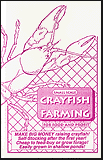
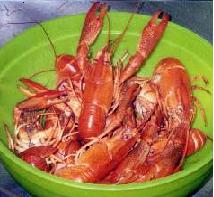 The crayfish is a very promising aquaculture species.
The crayfish is a very promising aquaculture species. This book is one of the few sources for complete information on all aspects of the culture of large-sized freshwater crayfish. Compiled from leading-edge research direct from University and individual findings all over the U.S., this book dispels the hype and furnishes the facts about this well known and highly prized aquaculture species. Fish farmers have become major players in this bottomless market in only a couple of years. Small scale family run operations are harvesting 'short lobsters' in less than a year, and the start-up costs are low. Included in the book are photos, food and feeding regimens needed to raise crayfish to giant size, well managed pond factors, hatching and juvenile production, stocking methods, sources of supply Crayfish Suppliers , sale & processing tips, and marketing recommendations. This book is easy to read, well organized, and packed with hard to find information. Targets the small farmer or homesteader.
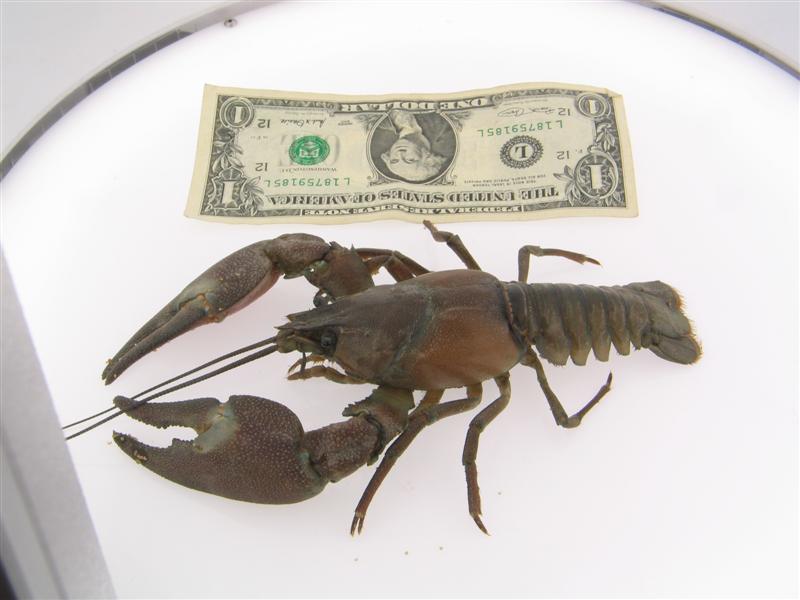
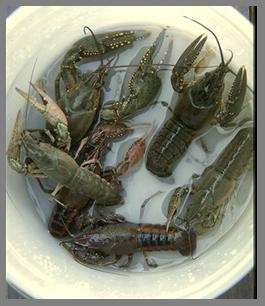 Look at these huge crawfish! How did they get so big? The answer is simple...
ideal growing conditions. These are a common
variety of crayfish found all over the U.S. except the South where summers are too hot
for them. Given the right conditions, they can attain this size (and larger!) in a
single season. After the first year, crayfish are 'self-stocking', meaning they
propagate naturally if allowed to. It is more efficient to raise the young in tanks
(giving a 98% survival rate), but that requires a little more effort. Careful harvesting
can produce ever-larger specimens if the largest crayfish are returned to the pond to
reproduce. The best production is obtained with a combination of natural and
processed feeds and lots of room. Crowding can stunt the growth of young crayfish greatly.
1 sq. foot per cray is ideal. Natural sources of food include hay, grass and other vegetation.
Processed feeds include range pellets, dog food, sinking fish food, and of course crayfish feed.
Stock can be obtained from existing crayfish farms as juveniles or adults, or one can
capture a local variety of crawdad quite easily.
Look at these huge crawfish! How did they get so big? The answer is simple...
ideal growing conditions. These are a common
variety of crayfish found all over the U.S. except the South where summers are too hot
for them. Given the right conditions, they can attain this size (and larger!) in a
single season. After the first year, crayfish are 'self-stocking', meaning they
propagate naturally if allowed to. It is more efficient to raise the young in tanks
(giving a 98% survival rate), but that requires a little more effort. Careful harvesting
can produce ever-larger specimens if the largest crayfish are returned to the pond to
reproduce. The best production is obtained with a combination of natural and
processed feeds and lots of room. Crowding can stunt the growth of young crayfish greatly.
1 sq. foot per cray is ideal. Natural sources of food include hay, grass and other vegetation.
Processed feeds include range pellets, dog food, sinking fish food, and of course crayfish feed.
Stock can be obtained from existing crayfish farms as juveniles or adults, or one can
capture a local variety of crawdad quite easily.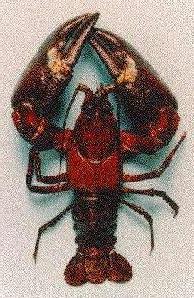
(left) This is a somewhat rare variety of crayfish (Pacifasticus), found in Pacific Northwest streams and lakes. It grows much larger than other varieties in the U.S.; unfortunately it takes 18 months or so to mature and breed. This makes it not too well suited for culture..except in that region.
Sometimes called a 'short lobster, this variety can be raised indoors in tanks. These can be relatively easy and inexpensive to establish and manage. Using tanks can create an extended growing season, necessary in colder climates. Other benefits of tank culture include..controlled environmental factors (turbidity, temperature, waste management), safety from predators, and controlled feed intake--all of which produce maximum growth rate, highly efficient reproduction rates, and the highest possible weight at harvest.
Simple selective breeding can increase the size and disease resistance of successive generations, as in the now famous 'Super Shrimp' of Mexico.
There are over 300 species of freshwater crayfish in the U.S.A...all sizes, colors, temperments. There are several varieties that thrive in almost every environmental niche. Some are better suited for farming than others, and there is a suitable species for almost any climate in the U.S.
Reviewer: A reader from Paintsville, KY: "This is an excellent source of information for people who want to start a crayfish farming business. It covers all aspects, including pond and tank culture, sexing, feeding requirements, and sources for crayfish".
from'BACKWOODS HOME MAGAZINE' by Dave Duffy, editor: "This is a small but useful book..a bare bones 'how-to' manual on how to raise crayfish in a small country setting. Wilson is a clear, informative writer, and this book is in that vein.. short and to the point. No fluff. I like it a lot."
Reviewer: Terri Primavera: "Both this book and the Red Claw book were great! I stayed up really late perusing them last night. I'm hoping to visit a couple of local farms in the near future in the hopes to learn more about starting my own crayfish farm.
from 'AQUACULTURE MAGAZINE' by James W. Avault, book review editor & former editor of the Journal of World Mariculture: "This 45 page book is broken down into two sections, easy to read, well organized..and packed with information."

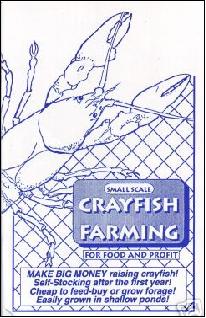

To place an order for this book,
send check or MO for $ 12.00 (includes shipping) per book to:
(THESE BOOKS ARE ONLY AVAILABLE IN THE UNITED STATES. SORRY NO BOOKS WILL BE SHIPPED TO INTERNATIONAL ADDRESS.)
Atlas Publications
Kenneth Spruce CEO
216 Soaring Eagle Dr.
Murphy, N.C. 28906-5729
OR
BUY NOW online with PayPal or credit card--usually ships in 48 hrs,United States address only,
NO INTERNATIONAL ADDRESS.

Click to see this site.
©2012 Atlas Publications
E-mail Ken Spruce at kaspruce@aol.com or atlaspub201@gmail.com